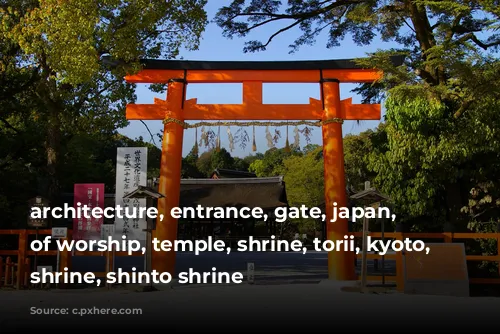Visiting temples and shrines in Japan is a profound experience, offering a glimpse into the nation’s rich cultural heritage. With approximately 100,000 Buddhist temples and Shinto shrines scattered across the country, these sacred sites beckon travelers and locals alike. These places of worship are not only spiritual sanctuaries but also captivating tourist attractions, showcasing stunning architecture and tranquil gardens.
To fully appreciate the beauty and serenity of these sacred spaces, it’s vital to understand and practice appropriate etiquette. Respecting these customs ensures a harmonious experience, honoring the traditions and beliefs deeply ingrained in Japanese culture. This guide provides a comprehensive overview of essential do’s and don’ts, ensuring your visit is both meaningful and culturally sensitive.

Paying Your Respects: A Glimpse into Rituals
Before entering a Shinto shrine, a symbolic gesture of respect is customary. The torii gate, a traditional archway marking the entrance to a shrine, symbolizes the transition from the secular world to the sacred realm. A slight bow before stepping through the torii honors the guardian deities residing within the shrine’s grounds. When navigating the pathway, remember to stay to the side, as the center is reserved for the divine beings.
A sense of reverence extends to dress as well. While there is no strict dress code, consider wearing smart casual or comfortable yet conservative attire. Respecting the spiritual atmosphere of these locations is paramount, as many locals visit for prayer and reflection.
Purification Rituals: Cleansing Body and Mind
Upon entering a temple or shrine, you’ll encounter a temizuya or chozuya – a purification fountain or basin. This is where worshippers perform a symbolic cleansing ritual to purify their hands and mouth.
To participate in this ritual, follow these simple steps:
- Take a wooden ladle and fill it with water.
- Rinse your left hand, then your right hand.
- Transfer water to your cupped left hand and bring it to your mouth. (Remember, this is a symbolic purification; the water is not meant to be consumed).
- Rinse your left hand again.
- Cleanse the ladle by drawing fresh water and allowing it to flow down the handle. This ensures the ladle is purified for the next person.
Entering the Sacred Space: Signs of Respect
Stepping inside many temples requires removing your shoes. Designated shelves or plastic bags are provided for storing your footwear. This practice reflects respect for the sacredness of the temple and contributes to maintaining a clean environment.
Prayer and Offerings: Connecting with the Divine
Praying inside a temple or shrine is a personal and meaningful experience. When approaching the offering box, a monetary offering is typically placed. This can be a few coins, symbolizing gratitude and respect.
The prayer process varies slightly between Buddhist temples and Shinto shrines:
Buddhist Temples:
- Place your palms together and bow deeply.
- Clapping hands is not customary inside temples.
- After your prayer, bow lightly and exit.
Shinto Shrines:
- Place your palms together and bow deeply twice.
- After bowing, offer your prayer.
- Ring the bell by pulling the rope (if available) to symbolically call the deity’s attention.
- Bow lightly again before leaving.
Incense: An Offering of Gratitude
Burning incense is a common practice at both temples and shrines, signifying an offering to enhance your prayer and purify the environment. Incense sticks are often available for purchase.
To burn incense correctly:
- Light the incense stick.
- Allow it to burn for a few seconds.
- Extinguish the flame by gently waving your hand, rather than blowing on it.
- Place the incense in the provided burner.
Avoiding Impurities: Respecting Tradition
To ensure a respectful visit, certain practices are discouraged.
Taking photos indiscriminately is not always permitted. While photography outside the main halls is often allowed, remember to check for signage. If a “No Photography” sign is present, respect the request and refrain from taking photos.
Visiting when ill, mourning, or injured is also traditionally discouraged. These conditions are believed to carry impurities, potentially disrupting the sacred atmosphere.
Exploring Japanese Tradition: Souvenirs of Good Fortune
Your visit to a temple or shrine can be enhanced by purchasing traditional souvenirs.
Omamori, protective amulets, are believed to safeguard against illness and bring good fortune. These charming drawstring bags are offered in various colors and designs.
Omikuji, fortune slips, provide glimpses into the future. Positive slips can be kept, while negative ones can be tied to a nearby tree or wire, symbolically releasing the bad fortune.
Ema, wooden prayer boards, offer a tangible way to express your wishes. Write your wish and, traditionally, your name and birthday on the board and hang it at the shrine.
Embarking on your Japanese Temple and Shrine Journey
Exploring Japan’s temples and shrines is a rewarding journey that combines spiritual contemplation with cultural immersion. By respecting the customs and traditions, you can connect with the rich history and spiritual significance of these sacred places. Remember to be mindful, respectful, and embrace the serenity that permeates these sacred grounds.
For more information about Japan and exciting adventures, visit KKDay!

